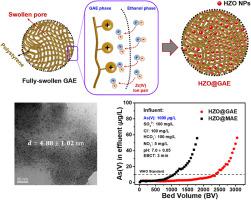Journal of Hazardous Materials ( IF 12.2 ) Pub Date : 2021-02-24 , DOI: 10.1016/j.jhazmat.2021.125505 Zhuoyao Fang , Ziniu Deng , Airong Liu , Xiaolin Zhang , Lu Lv , Bingcai Pan

|
Given high selectivity and excellent stability, zirconium oxides are very promising in selective removal of arsenic, fluorine, and phosphorus from water. Nevertheless, it remains challenging to prepare sub-10 nm zirconium oxides of ultra-high adsorptive reactivity. Herein, we prepared hydrated zirconium oxides (HZO) of 4.88 ± 1.02 nm by conducting in-situ precipitation of nanoparticles (NPs) inside the gel-type anion exchanger (GAE). GAE was swollen in water and contained lots of < 10 nm swollen pores, restricting excess growth of HZO NPs. In comparison, the NPs formed inside the macroporous anion exchanger (MAE) possessed an average diameter of 30.91 ± 8.98 nm. XPS O1s analysis indicated that the oxygen sites in the gel-type nanocomposite (HZO@GAE) possessed a much higher proportion (48.9%) of reactive terminal oxygen (-OH) than the macroporous nanocomposite (HZO@MAE, 21.2%). Thus, HZO@GAE exhibited significantly enhanced adsorption reactivity toward As(V)/As(III) than HZO@MAE. The exhausted HZO@GAE could be fully regenerated by alkali treatment for repeated use without any loss in decontamination efficiency. In column assays, the HZO@GAE column successively produced ~2400 bed volume (BV) clean water ([As]<10 μg/L) from synthetic groundwater, exceeding twice the amount produced by the HZO@MAE column. This study may shed new light on developing highly efficient nanocomposites for water decontamination.
中文翻译:

通过使用限制在凝胶型阴离子交换剂内部的亚10 nm水合氧化锆增强从水中的砷去除
鉴于高选择性和出色的稳定性,氧化锆在从水中选择性去除砷,氟和磷方面非常有前途。然而,制备具有超高吸附反应性的低于10 nm的氧化锆仍然具有挑战性。在这里,我们通过在凝胶型阴离子交换剂(GAE)内进行纳米颗粒(NPs)的原位沉淀制备了4.88±1.02 nm的水合氧化锆(HZO)。GAE在水中溶胀,并包含许多<10 nm溶胀的孔,从而限制了HZO NP的过度生长。相比之下,在大孔阴离子交换剂(MAE)内部形成的NP的平均直径为30.91±8.98 nm。XPS O1s分析表明,凝胶型纳米复合材料(HZO @ GAE)中的氧位置所占比例更高(48。9%)的反应性末端氧(-OH)比大孔纳米复合材料(HZO @ MAE,21.2%)高。因此,与HZO @ MAE相比,HZO @ GAE对As(V)/ As(III)的吸附反应性显着增强。耗尽的HZO @ GAE可以通过碱处理完全再生以重复使用,而不会降低去污效率。在色谱柱分析中,HZO @ GAE色谱柱连续从合成地下水中产生了约2400床体积(BV)的纯净水([As] <10μg/ L),超过了HZO @ MAE色谱柱产生的两倍。这项研究可能为开发用于水净化的高效纳米复合材料提供新的思路。耗尽的HZO @ GAE可以通过碱处理完全再生以重复使用,而不会降低去污效率。在色谱柱分析中,HZO @ GAE色谱柱连续从合成地下水中产生了约2400床体积(BV)的纯净水([As] <10μg/ L),超过了HZO @ MAE色谱柱产生的两倍。这项研究可能为开发用于水净化的高效纳米复合材料提供新的思路。耗尽的HZO @ GAE可以通过碱处理完全再生以重复使用,而不会降低去污效率。在色谱柱分析中,HZO @ GAE色谱柱连续从合成地下水中产生了约2400床体积(BV)的纯净水([As] <10μg/ L),超过了HZO @ MAE色谱柱产生的两倍。这项研究可能为开发用于水净化的高效纳米复合材料提供新的思路。











































 京公网安备 11010802027423号
京公网安备 11010802027423号